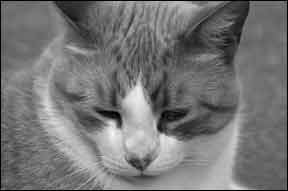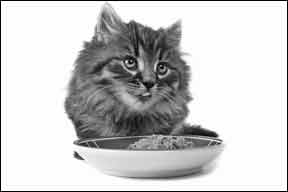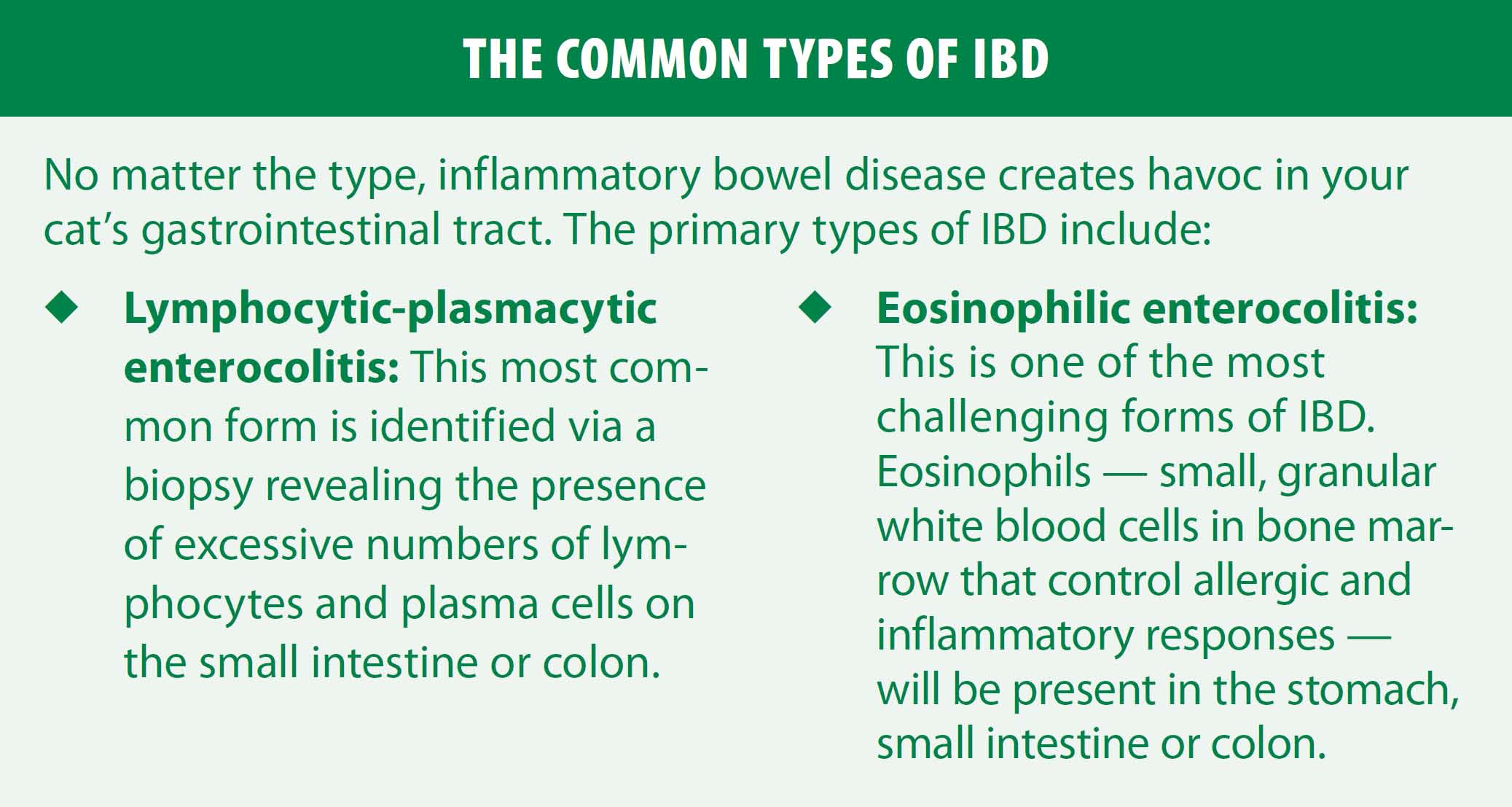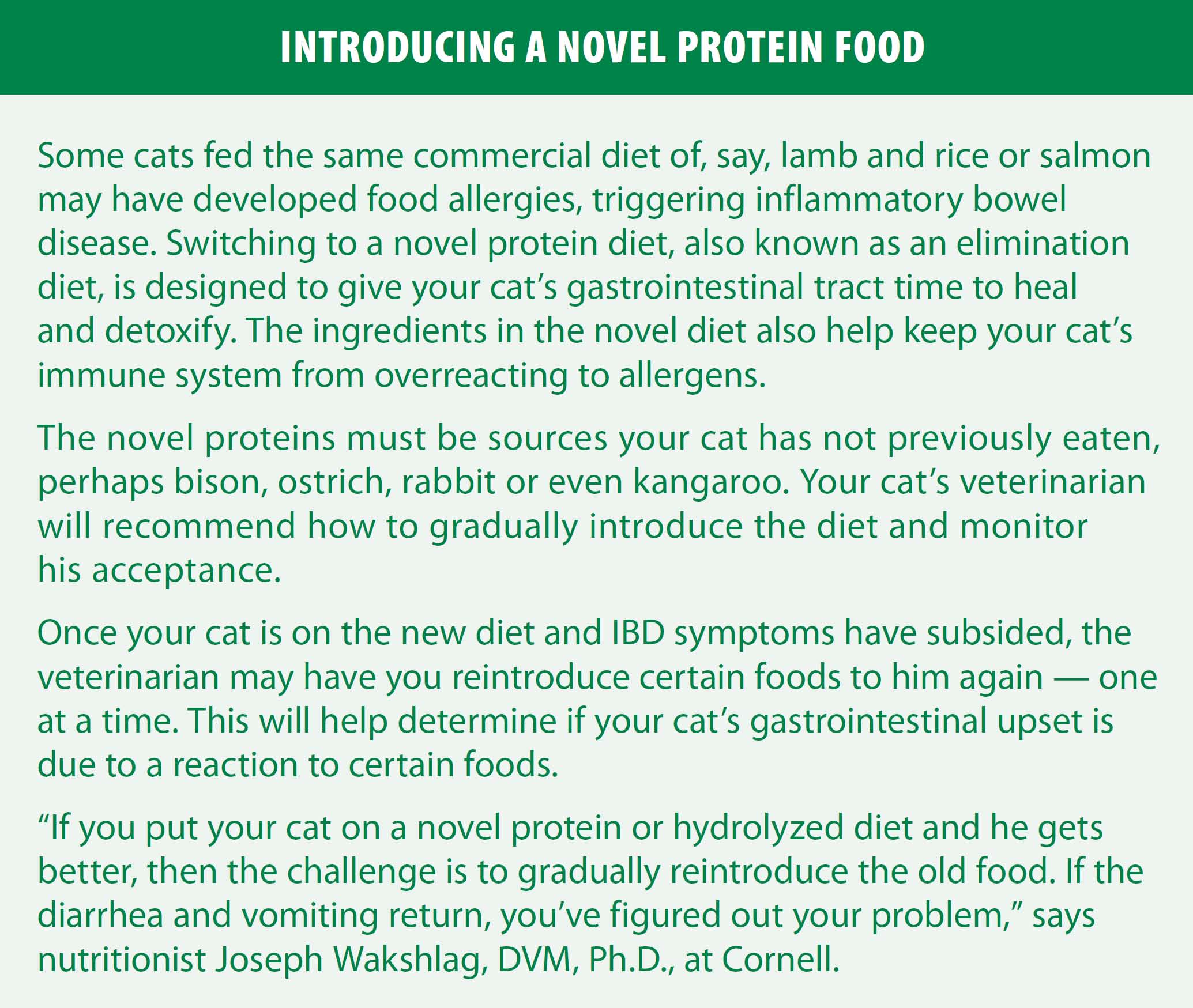While the cure for inflammatory bowel disease remains elusive, new strides on the nutritional and pharmaceutical fronts are helping affected cats lead healthier lives. The use of novel or hydrolyzed diets coupled with the administration of the synthetic steroid prednisolone seems to offer an effective one-two therapeutic punch for most cats diagnosed with IBD, says Joseph Wakshlag, DVM, Ph.D., Associate Professor of Clinical Nutrition at the Cornell University College of Veterinary Medicine.

288
By definition, IBD is an umbrella term that describes a group of chronic gastrointestinal disorders. The most common is lymphocytic-plasmacytic enterocolitis. Other forms include eosinophilic enterocolitis and granulomatous enteritis.
Immune Reaction. No matter what type of IBD your cat has, he may be in pain due to the increased number of inflammatory cells in the lining of his stomach, small intestine and colon. With IBD, a cat’s immune system reacts to the presence of pathogenic agents, including bacteria or food antigens, and the mucosal lining responsible for regulating the digestion and absorption of food is impaired.
“Cats suffering from IBD tend to become more lethargic, sleep more, do not act like themselves, lose weight and experience vomiting, diarrhea and have a decrease in appetite,” Dr. Wakshlag says. “They are just not acting like their perky selves or greeting you like they used to. It becomes a messy problem in some cats with such irritable bowels that they experience uncontrollable diarrhea in or outside the litter box.”
Some cats with IBD can also suffer vitamin B12 deficiency. B12 is a major factor for red blood synthesis and deficiency of this vitamin can lead to mild anemia and weight loss. Some cats may display symptoms intermittently or be mistakenly assumed to be trying to hack up hairballs.
Ruling Out Causes. Although cats of any age can be affected, middle-aged or older cats are more susceptible to IBD. “We don’t know what causes IBD, so when a cat is having uncontrollable diarrhea, vomiting and acting lethargic, we start ruling out possible causes such as parasites and cancer, and we back our way into diagnosing IBD,” Dr. Wakshlag says. “What we do know with certainty is that cats with IBD have gastrointestinal discomfort and there is constant inflammation in their intestinal walls.”
If your cat is exhibiting these symptoms, his veterinarian will most likely perform a series of diagnostic tests to rule out other conditions, such as feline leukemia virus, feline infectious peritonitis, feline immunodeficiency virus, or parasites and protozoal infections. The tests may include a complete blood cell count, a fecal examination for the presence of parasitic and bacterial agents, and abdominal X-rays and ultrasound.
However, the definitive diagnosis is achieved by the use of an endoscope, a flexible tube with optical fibers that obtains images of the cat’s stomach and intestinal tract. “Your vet may want to perform an endoscopy to look at your cat’s stomach, small intestine and colon and take small surface biopsies of the stomach or intestine to confirm the diagnosis,” Dr. Wakshlag says.

288
Nutritional Plan. Once IBD has been identified, the best treatment for most cats involves managing their diets and/or administering oral prednisolone. The nutritional game plan calls for switching to a novel protein diet, such as therapeutic commercial diets containing ostrich, bison or duck, to address possible food allergies. The new diets must be introduced gradually to avoid additional GI upset.
“Switching to a novel protein diet won’t cure the affected cats, but in 40 to 60 percent of the cases, they will have good digestive function,” says Dr. Wakshlag. “There is also the hydrolyzed protein diet option.”
Hydrolyzed proteins are broken down into minuscule particles too tiny to trigger a response from the cat’s immune system. Major commercial pet food companies market these diets directly to veterinarians.
“People often try the novel food approach first because it is easy,” says Dr. Wakshlag. “Sometimes, switching to a more digestible food with a better fiber matrix can help a cat get better.”
He adds that it’s important to work closely with your cat’s veterinarian to identify a novel protein diet or use a hydrolyzed protein diet to ensure the greatest success in your cat.
The corticosteroid prednisolone currently ranks as the go-to drug in easing symptoms associated with IBD “We know the dose and how to use it judiciously,” Dr. Wakshlag says. “At Cornell, we often get the most severe cases of cats and dogs with IBD. It is important to give prednisolone to cats orally for the most effective administration. Most cats do fine on prednisolone and it is the cheapest drug option.”
Risk of Infection. However, he cautions against its long term use. Prednisolone can cause insulin resistance and lead to diabetes mellitus, and if a cat is on the medication and gets bitten, there is a greater risk for bacterial infection. Predisolone also suppresses the body’s natural cortisol secretion; therefore, it’s always important to taper cats off prednisolone to allow your cat’s system to start making his own steroids again.”
Corticosteriods fight inflammation, stimulate the appetite and enhance water absorption. Other drugs used with some success are chlorambucil, another immunosuppressant, and antibiotics.
Thanks to advances in veterinary diagnostic tools, especially the endoscope, more cats are being properly diagnosed with IBD, Dr. Wakshlag says. “My take-home message to owners is that sometimes the introduction of a novel protein or hydrolyzed diet — coupled with the right medication — can show results within a few days. Cats with IBD feel miserable, but with the right treatment plan, most can experience a livable outcome.”

450

450



